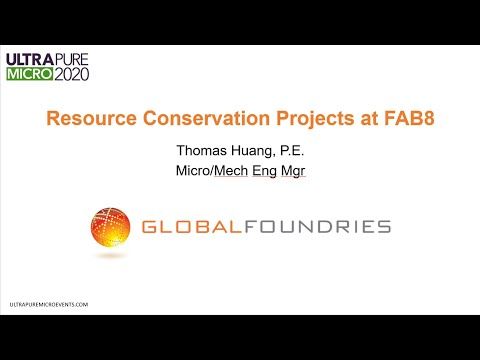
Collaborators
Tags
WastewaterWastewater ProjectQ&A Results with GlobalFoundries: Chemical Inhibition to Biological Wastewater Treatment
Answers to your questions to this UPM 2023 GlobalFoundries and Farnsworth Group presentation.
Share this insight
At the 2023 UPM Conference, Zeph Egnasher, Facilities Engineer, UPW/WWT at GlobalFoundries and Brandon Ekberg, Principal, Farnsworth Group jointly delivered the presentation: Chemical Inhibitors to Biological Wastewater Treatment - Impact Analysis and Management Considerations for Facility Design.
The presentation explored the impact of azoles, which are contaminants of concern used in semiconductor manufacturing which inhibit the nitrification of ammonia at the Publicly Owned Treatment Works (POTW). Understanding and remediating the effects of azoles are high on the industry agenda.
In this forum, both authors have delivered answers to audience questions.
- Did the POTW highlight this because of an impact seen at their plant? The collaborative study was performed proactively to evaluate the impact of a known nitrification-inhibiting compound. The purpose was to enact appropriate control measures and site chemical management practices to limit impact to the partner POTW while facilitating manufacturing growth.
- A major source of azoles is CMP slurries, but are azoles used in cooling towers an important consideration as well? Yes, azoles in industrial water treatment chemicals can also contribute to the site azole concentrations. From a specific site azole discharge mass balance, we found that Chemical Mechanical Planarization (CMP) slurries contributed to >60% of the site effluent mass loading, so our studies referenced this input stream as a primary contributor. However, as part of overall azole discharge management strategy, GlobalFoundries is coordinating with cooling tower corrosion treatment chemical suppliers to pilot alternative chemistries with lower inhibition properties.
- Is there a means to measure azole discharge levels online to help find the sources? To our knowledge, no continuous online analytical method has been commercially developed specifically for quantification of azoles in wastewater or water. Analysis is often performed on discrete samples, often employing Gas Chromatography-Mass Spectrometry (GC/MS).
- How do you avoid knee jerk discharge rejections when opening communication with POTWs on "suspected inhibitors"? Open discussion, effective modelling, pilot testing. There is available baseline reference documentation such as the US EPA EcoTox database that POTWs often rely on, but this does not specifically address biological inhibition. Published aquatic toxicity and biomass inhibition cannot always be referenced as analogues when making an initial assessment. Maintaining a dynamic site water/wastewater discharge/chemical model is key to discuss concentration-based projections with the POTW.
- You highlighted different IC50 levels for two different POTWs - has there been any speculation on what differences drive that? Local concentrations, local design conditions, seasonal variations/average temperature, biomass differences and tolerances all drive these variations. Data from the study comparing a biomass that has been exposed to azole-containing industrial wastewater, as opposed to biomass that does not experience this loading, provides some evidence that there may be acclimation of the biomass to the influent conditions. Furthering the hypothesis of acclimation, at the time of this study, the GlobalFoundries FAB 8 receiving POTW biomass was exposed to a new FAB ramp over the course of 6 years, with cumulative introduction of chemistries in the total site discharge.
- Is there any evidence that the biomass can build resistance to azole presence when introduced at gradually increasing concentration? This was not directly studied or addressed in the evaluations included in the scope of the presentation. However, the GlobalFoundries/University of Arizona study demonstrated in Slide 8 provides indication of the possibility that a nitrifying biomass may acclimate to influent conditions over time. There is a small market segment of specialty suppliers that provide bioengineered micro-organisms for specialty wastewater treatment. This is an interesting concept, but not widely commercialized.
- What MLSS concentration(s) were the tests run at? ISO9509 test protocol provides provisional guidelines that normalize for MLSS concentrations, and factors measured MLSS into the specific nitrification rate calculation. For the purposes of the majority of the studies referenced, MLSS was approximately 3g/L.
- Is there any effort to review impacts of the azoles beyond the POTW? (Into their outfall)? This was not studied, but the downstream impacts can influence discharge limits. The US Environmental Protection Agency (EPA) has provided no specific guidance or comment on azoles as an emerging contaminant of concern for point source discharges under the National Pollutant Discharge Elimination System (NPDES). Environmental impact pathways and lifecycle of azole discharge from semiconductor manufacturing may eventually become a topic that is broached as part of a review study cycle for 40CFR Part 469.
View the slides here: Chemical Inhibitors to Biological Wastewater Treatment - Impact Analysis and Management Considerations for Facility Design
Share this insight
Related resources
HFRO: A Capacity Crunch Paves the Road to Future Development
Chemical Inhibitors to Biological Wastewater Treatment - Impact Analysis and Management Considerations for Facility Design

Resource Conservation Projects at GLOBALFOUNDRIES Fab8 in Malta, New York

